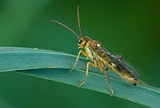
Tenthredinidae
Encyclopedia
The Tenthredinidae is the largest family of sawflies, with well over 6000 species worldwide. Larvae are typically herbivore
s and feed on the foliage of trees and shrubs, with occasional exceptions that are leaf miner
s, stem borers, or gall
makers. The larvae of externally feeding species resemble small caterpillars. They go through complete metamorphosis.
The family has no easily seen diagnostic features, though the combination of 5-9 antennal flagellomeres plus a clear separation of the first abdominal
tergum
from the metapleuron can reliably separate them. These sawflies are often black or brown, and from 3-20 mm long. Like other sawflies they lack the slender "wasp-waist," or petiole
, between the thorax and abdomen, characteristic of many Hymenoptera
ns . The mesosoma (or thorax) and the metasoma (abdomen) are instead broadly joined. The Tenthredinidae are also often somewhat dorso-ventrally flattened which will distinguish them at least from the slender Cephids
(which, together with the common sawflies comprise many of the Nearctic species of Symphyta).
Females use their sawlike ovipositor to cut slits through barks of twigs, into which translucent eggs are wedged, which damages the trees. They are common in meadows, and in forest glades near rapid streams. Adults eat little, while larvae feed on foliage of streamside trees and shrubs, especially willow.
A number of species and genera have been described from the fossil record
such as Eriocampa tulameenensis
and Pseudosiobla campbelli of British Columbia.
Herbivore
Herbivores are organisms that are anatomically and physiologically adapted to eat plant-based foods. Herbivory is a form of consumption in which an organism principally eats autotrophs such as plants, algae and photosynthesizing bacteria. More generally, organisms that feed on autotrophs in...
s and feed on the foliage of trees and shrubs, with occasional exceptions that are leaf miner
Leaf miner
Leaf miner is a term used to describe the larvae of many different species of insect which live in and eat the leaf tissue of plants. The vast majority of leaf-mining insects are moths , sawflies and flies , though some beetles and wasps also exhibit this behavior.Like Woodboring beetles, leaf...
s, stem borers, or gall
Gall
Galls or cecidia are outgrowths on the surface of lifeforms caused by invasion by other lifeforms, such as parasites or bacterial infection. Plant galls are abnormal outgrowths of plant tissues and can be caused by various parasites, from fungi and bacteria, to insects and mites...
makers. The larvae of externally feeding species resemble small caterpillars. They go through complete metamorphosis.
The family has no easily seen diagnostic features, though the combination of 5-9 antennal flagellomeres plus a clear separation of the first abdominal
Abdomen
In vertebrates such as mammals the abdomen constitutes the part of the body between the thorax and pelvis. The region enclosed by the abdomen is termed the abdominal cavity...
tergum
Tergum
A tergum is the dorsal portion of an arthropod segment other than the head. The anterior edge is called the base and posterior edge is called the apex or margin. A given tergum may be divided into hardened plates or sclerites commonly referred to as tergites...
from the metapleuron can reliably separate them. These sawflies are often black or brown, and from 3-20 mm long. Like other sawflies they lack the slender "wasp-waist," or petiole
Petiole (insect)
In entomology, the term petiole is most commonly used to refer to the constricted first metasomal segment of members of the Hymenopteran suborder Apocrita; it may be used to refer to other insects with similar body shapes, where the metasomal base is constricted...
, between the thorax and abdomen, characteristic of many Hymenoptera
Hymenoptera
Hymenoptera is one of the largest orders of insects, comprising the sawflies, wasps, bees and ants. There are over 130,000 recognized species, with many more remaining to be described. The name refers to the heavy wings of the insects, and is derived from the Ancient Greek ὑμήν : membrane and...
ns . The mesosoma (or thorax) and the metasoma (abdomen) are instead broadly joined. The Tenthredinidae are also often somewhat dorso-ventrally flattened which will distinguish them at least from the slender Cephids
Cephoidea
The Cephoidea are a small superfamily within the Symphyta, containing some 100 species in a single family, Cephidae, commonly referred to as stem sawflies. Most species occur in the Northern Hemisphere, especially in Eurasia. The larvae are stem borers in various plants, especially grasses, but...
(which, together with the common sawflies comprise many of the Nearctic species of Symphyta).
Females use their sawlike ovipositor to cut slits through barks of twigs, into which translucent eggs are wedged, which damages the trees. They are common in meadows, and in forest glades near rapid streams. Adults eat little, while larvae feed on foliage of streamside trees and shrubs, especially willow.
A number of species and genera have been described from the fossil record
Fossil
Fossils are the preserved remains or traces of animals , plants, and other organisms from the remote past...
such as Eriocampa tulameenensis
Eriocampa tulameenensis
Eriocampa tulameenensis is an extinct species of sawfly in the family Tenthredinidae that is known from early to early middle Eocene lake deposits near the small community of Princeton, British Columbia in the Similkameen region....
and Pseudosiobla campbelli of British Columbia.
External links
- Hymis de Image gallery

